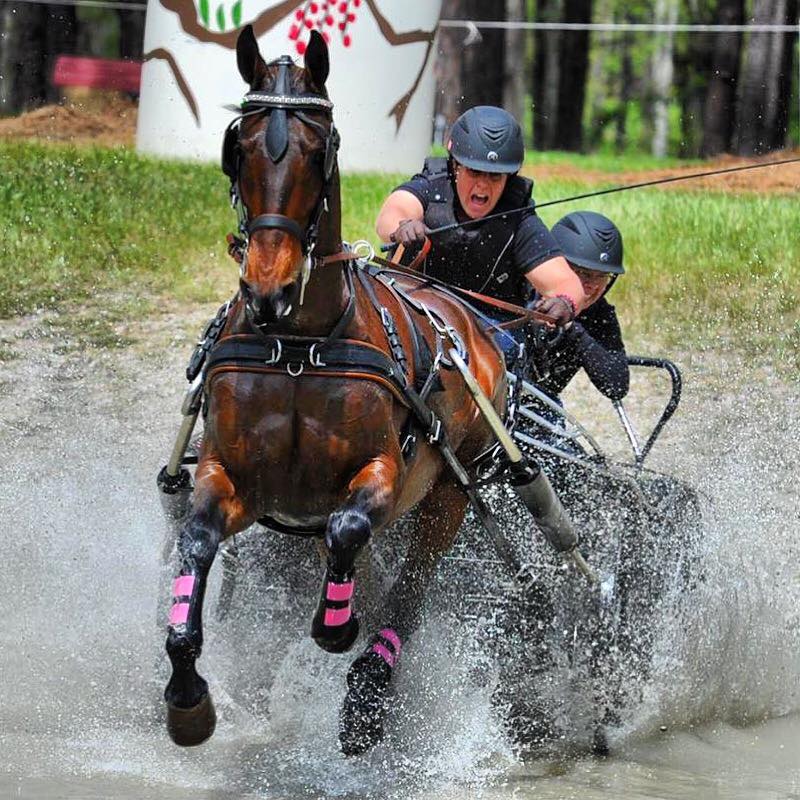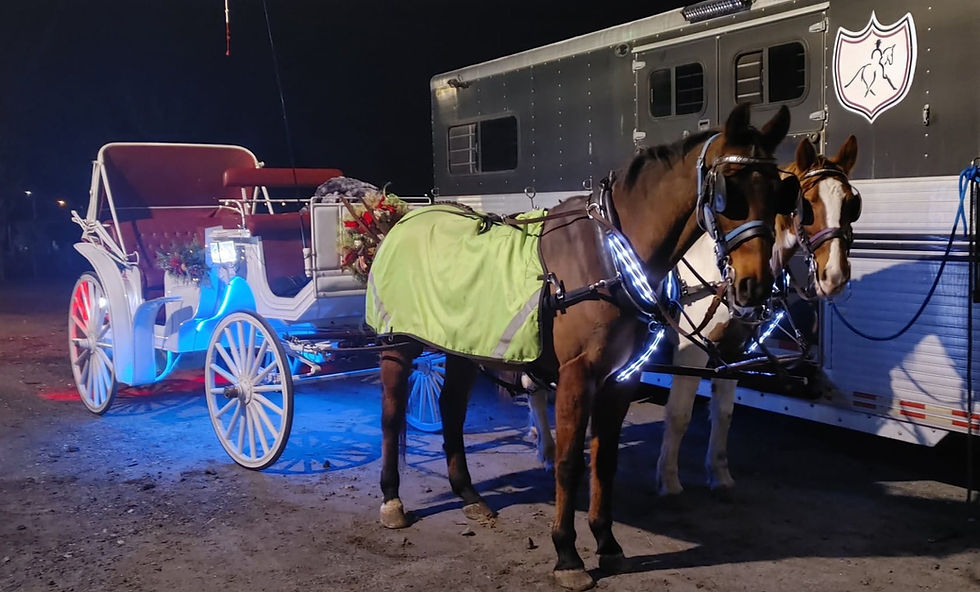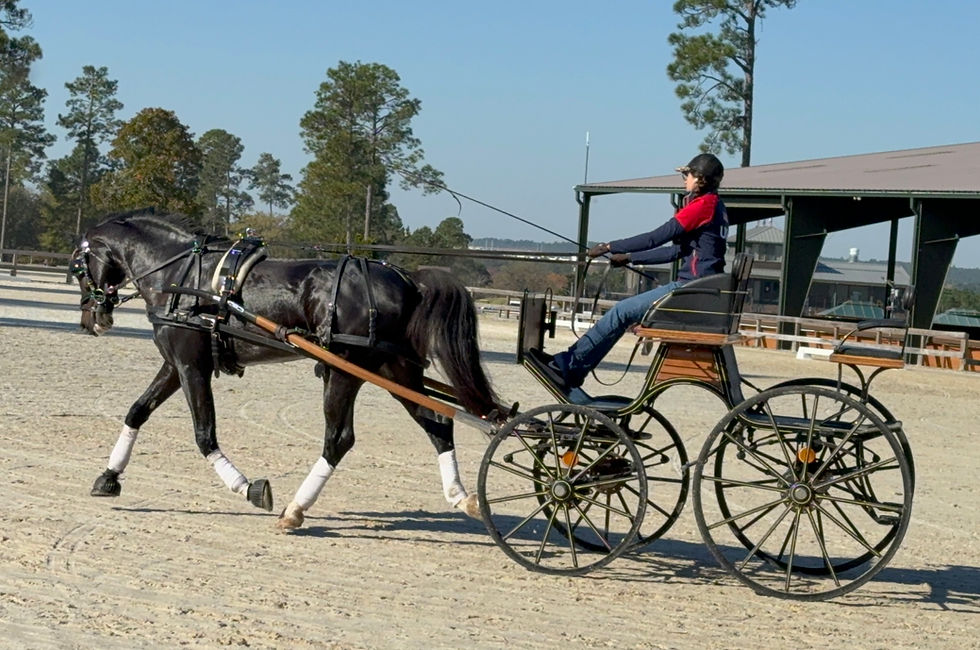City Streets to Competition Fields
- jess3152

- Oct 2
- 4 min read
From City Streets to Competition Fields: My Journey from Commercial Carriage Driver to Professional Combined Driving Trainer

When I first picked up the lines as a commercial carriage driver, my world was a swirl of city streets, curious tourists, and horses who knew their routes better than most cab drivers. It was hard work, requiring long hours, constant patience, and a deep understanding of my equine partners. At the time, I never imagined that those early days would set the foundation for a career in competitive combined driving and eventually training others at the professional level.
Learning the Basics on the Job
Driving a carriage for the public teaches you more than just how to guide a horse from point A to point B. You learn how to manage unpredictability: honking horns, impatient traffic, clattering skateboards, and sudden distractions that can spook even the steadiest horse. Those experiences forced me to develop a quiet seat, soft hands, and—most importantly—a calm presence.

I discovered early on that horses look to their driver for leadership in every situation. A tight corner, a barking dog, or a flashing ambulance all require the same response: breathe, communicate, and trust. These are the same fundamentals I now teach my students, but back then, I was learning through pure necessity.
Transitioning to Sport
When I first saw a combined driving event, I was struck by the energy—it was everything I loved about driving, distilled into a thrilling test of precision, speed, and partnership. Dressage demanded elegance and harmony, marathon challenged both horse and driver with stamina and strategy, and cones tested accuracy under pressure.

I realized that what I’d been doing in the city—threading a horse and carriage through narrow streets, negotiating unexpected obstacles, and presenting a calm, confident team to the public—wasn’t so different from what competitors did in the arena. The difference was intention. Combined driving wasn’t about offering a ride; it was about performance, athleticism, and pushing both horse and driver to their full potential.
The Professional Shift
Moving from carriage driving to competitive training required me to unlearn some habits and refine others. On the commercial side, efficiency and routine ruled the day. But in the sport, every detail mattered: from harness fit to conditioning schedules, from the balance of the carriage to the rhythm of a half-halt.
I began working with seasoned trainers, immersing myself in the world of FEI rules, marathon course maps, and the finer points of rein handling. Slowly, I realized I wasn’t just driving anymore—I was developing a system for training horses and coaching drivers.
Training Students and Client Horses

Today, much of my time is spent helping students and client horses prepare for combined driving events. No two training programs look alike, because every horse and driver bring their own strengths and challenges to the table. Still, most follow the same phases of progression, which keep training systematic and fair.
Phase 1: Foundation Work
Everything begins on the ground. Horses must first understand voice aids, rein cues, and whip signals before they ever pull a carriage. I use long-lining and ground driving extensively at this stage to build muscle, straightness, and confidence. For new students, this phase focuses on rein handling and body position—learning how to communicate clearly without overusing the hands.
Phase 2: Basic Hitching and Fitness
Once a horse is comfortable and responsive, we introduce the carriage. Sessions are short and simple—walk, trot, and large circles—so the horse learns to balance and push into the harness without tension. Drivers begin to practice transitions, half-halts, and basic figures. Building fitness also starts here, with a gradual program of conditioning rides that prepares both horse and driver for longer days of competition.
Phase 3: Dressage Development

With balance and basics established, the focus shifts to refinement. Horses learn bending, lateral work, and rhythm, while drivers refine their feel and timing. I often remind students that dressage is the root of everything: if the horse is supple and obedient in the dressage ring, they’ll be easier to handle in marathon obstacles and cones. This is the stage where finesse becomes just as important as strength.
Phase 4: Cones Training

Cones are deceptively simple but incredibly technical. At this stage, we start threading through patterns of cones, teaching both horse and driver precision and straightness. Students practice finding their rhythm, looking ahead, and maintaining accuracy under pressure. Horses, meanwhile, develop confidence in staying straight and adjustable at speed.
Phase 5: Marathon and Obstacles

Finally, once the basics are solid, we add the thrill of marathon work. Horses learn to navigate water, steep turns, and varied terrain while maintaining rhythm and obedience. For drivers, this phase builds strategy—learning to read a course, plan lines, and stay calm even when seconds count. Safety is paramount here, so every step is progressive, ensuring horse and driver never feel rushed.
Phase 6: Competition Readiness
The final stage isn’t just about polishing skills—it’s about preparation. Horses need a conditioning schedule that matches the demands of a competition weekend, including interval work, recovery, and stamina training. Drivers practice full tests under pressure, simulate marathon sections, and work on mental focus. I coach students not just on technique, but on mindset: how to handle nerves, recover from mistakes, and enjoy the sport no matter the result.
Coming Full Circle

Looking back, I see how essential my commercial driving years were. They gave me patience, grit, and an instinct for safety that I carry into every training session. Today, when I help a student prepare for their first competition, I remind them: every mile you drive matters. Whether it’s down a bustling street or through a set of cones, each experience builds the foundation for partnership and success.
Becoming a professional combined driving trainer wasn’t a straight path—it was a winding road from city carriage rides to international arenas. But that’s the beauty of driving: it teaches you that every turn, every obstacle, and every partnership has something to teach you.




Comments